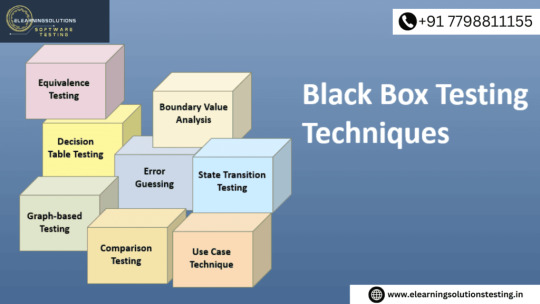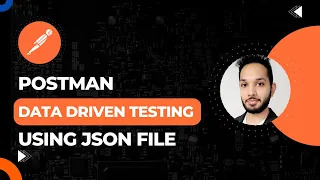#TestingTechniques
Explore tagged Tumblr posts
Text
Software testing is an essential aspect of software development that ensures the quality, reliability, and performance of applications. "The Art of Software Testing" by Glenford J. Myers is a classic book that provides a deep understanding of the principles, techniques, and best practices of software testing. Below is a user-friendly, step-by-step breakdown of the key outcomes and takeaways from the book, designed to help both beginners and experienced testers enhance their skills.
#SoftwareTesting#QA#QualityAssurance#SoftwareDevelopment#TestingBestPractices#TheArtOfSoftwareTesting#TechBooks#TestAutomation#ManualTesting#TestingTechniques#SoftwareTestingBooks#TestDrivenDevelopment#TechEducation#BugTracking#TestingMethodologies#TestStrategies#TechTutorial#TestCaseDesign#TestQuality#SoftwareEngineering#AgileTesting#ContinuousTesting#ProgrammingBooks#TestingTools#TestPlanning#SoftwareQuality#TestingCommunity
0 notes
Text
What is Black Box Testing?
Behavioral, opaque-box, closed-box, specification-based, and eye-to-eye testing are other names for black box testing. read more

#BlackBoxTesting#SoftwareTesting#QualityAssurance#TestingTechniques#TestAutomation#BugTesting#QAProcesses#TestingMethods
0 notes
Text
Aluminium Testing: Ensuring Quality and Reliability
Aluminium is a widely used metal known for its lightweight, strength, and corrosion resistance. To ensure the reliability and quality of aluminium products, aluminium testing plays a vital role. This process evaluates the metal’s composition, properties, and performance, helping industries meet required standards.
Importance of Aluminium Testing
Testing aluminium is crucial for:
Metal Analysis: Determining the chemical composition of aluminium to ensure it meets industry-specific requirements.
Quality Assurance: Ensuring the material adheres to standards for strength, durability, and performance.
Safety Compliance: Identifying impurities or inconsistencies that could compromise safety.
Common Aluminium Testing Methods
Optical Emission Spectrometry (OES): A fast and accurate method for detailed metal analysis.
X-Ray Fluorescence (XRF): Non-destructive testing to analyze the elemental composition.
Mechanical Testing: Examining tensile strength, hardness, and elasticity.
Corrosion Testing: Assessing the metal’s resistance to environmental conditions.
Applications of Aluminium Testing
Industries like automotive, aerospace, construction, and packaging rely on aluminium testing to:
Ensure product durability and reliability.
Meet regulatory standards and certifications.
Enhance production efficiency by identifying quality issues early.
Final Thoughts
Accurate metal analysis and aluminium testing are essential to maintaining high standards in manufacturing and industrial applications. By leveraging advanced testing techniques, businesses can ensure superior product quality and performance.
If you’re looking to enhance your aluminium testing capabilities, adopting modern analytical tools and methods is a wise investment. Explore Metal Power’s cutting-edge solutions to achieve precise metal analysis and superior testing results. Contact Metal Power today to transform your testing processes!
#metalpower#AluminiumTesting#metalanalysis#materialtesting#qualityassurance#TestingTechniques#AluminiumQuality
0 notes
Text
White Box Testing vs Black Box Testing: What’s the Difference?

Behind every functional software lies the truth of its testing - Black Box vs White Box. 📦 One focuses on end-user experience, while the other delves into the inner workings. Which approach reveals the hidden bugs? 💻
What is Black Box Testing?
Black Box Testing is a method where the tester doesn’t need to understand the internal workings of the application. Instead, the focus is on testing the functionality from an external user perspective. Think of it like testing an app without seeing the code inside—it’s all about inputs and outputs! 🌐
➢ Key Features of Black Box Testing 🎯
No Code Knowledge Required 🧑🏫: Testers only need to know the functionality, not the internal code.
Focus on User Experience 👥: Ensures the software works as users expect.
Applicable to All Levels 🛠️: Useful for unit, integration, and system testing.
Detects Functional Issues ⚠️: Helps uncover missing or incorrect features.
Uses Structured Test Cases 📜: Relies on predefined input/output test cases.
What is White Box Testing? 🔍
White Box Testing (or Clear Box Testing) is all about knowing and testing the code itself. Testers need a good understanding of the internal structure of the application, as they’re checking how well each piece of code functions and interacts. It’s a deep dive into the codebase! 🖥️💻
➢ Key Features of White Box Testing 🎯
Requires Code Knowledge 💻: Testers need coding skills to examine the internal workings.
Examines Internal Logic 🧠: Focus on code structure, algorithms, and logic flows.
Ideal for Unit Testing ⚙️: Best suited for smaller code segments and functions.
High Coverage 🔍: Ensures every path and branch in the code is tested.
Early Detection of Errors 🚫: Catches logical and security issues early in development.
Black Box vs White Box Testing: Key Differences 🐞
When it comes to "Black Box vs White Box Testing," each approach has its own strengths, weaknesses, and best use cases. Let’s compare them across some key areas! 🌐
1. Knowledge Requirement 🧑🏫
Black Box Testing doesn’t require any knowledge of the underlying code.
White Box Testing requires a good understanding of the code, making it more suitable for developers or technical testers.
2. Testing Focus 🎯
Black Box Testing focuses on functional aspects from a user’s point of view.
White Box Testing focuses on the structural aspects, such as code quality, logic, and flow.
3. Application 🖥️
Black Box Testing can be used for end-to-end testing scenarios.
White Box Testing is mostly used for unit testing and integration testing within smaller code segments.
4. Bug Detection 🐞
Black Box Testing finds functional bugs, such as incorrect or missing functionality.
White Box Testing finds structural and logical bugs within the code.
5. Automatability 🤖
Black Box Testing can be easier to automate for UI/UX testing, especially in large systems.
White Box Testing is often automated to improve code quality, especially in Continuous Integration (CI) setups.
When to Use Black Box vs White Box Testing?
Deciding between Black Box vs White Box Testing depends on the stage of development, your testing goals, and the skills of your team:
➢ Use Black Box Testing when you’re:
Testing from an end-user perspective 🧑💻
Running final QA checks before a release
Validating functionality for end-to-end workflows
Using non-technical testers for broader functional checks
➢ Use White Box Testing when you’re:
Conducting unit tests during early development 🛠️
Looking to improve code quality with CI/CD pipelines
Debugging specific sections of code or functions
Using automated testing tools to verify code logic and paths Both methods can complement each other! In fact, using them together (called Gray Box Testing) combines user-focused testing with code-level insights, providing a comprehensive test strategy. 🤩
Conclusion
When it comes to Black Box vs White Box Testing, the best approach often depends on your testing goals and project needs. Black Box Testing excels in validating the user experience and ensuring that the functionality meets expectations. White Box Testing, on the other hand, is invaluable for catching code-level issues and improving the security and quality of the code itself.
#BlackBoxTesting#WhiteBoxTesting#SoftwareTesting#TestingComparison#TechTalk#QATesting#SoftwareQuality#SoftwareDevelopment#Testing101#QualityAssurance#Debugging#SoftwareEngineering#ManualTesting#AutomatedTesting#CodeTesting#FunctionalTesting#UnitTesting#TechInsights#TestingTechniques
0 notes
Text
Complete Basics of API and API Testing using Postman
Discover the fundamentals of APIs and how to test them effectively using Postman. Learn to design, send requests, and automate tests for robust API development. This course covers everything from basic concepts to advanced testing techniques, ensuring you can build and maintain high-quality APIs. Elevate your skills and streamline your workflow with hands-on Postman practice

0 notes
Text
In an industry where a 2% increase in customer retention is equivalent to a 10% reduction in costs, enhancing customer experience is key.
Discover how QA and testing are pivotal in achieving this in our latest blog.
https://www.avisysservices.com/blog/how-testing-is-solving-the-most-annoying-problems-for-telcos/
#QA#testing#telecom#telecommunications#customerexperience#customerretention#qualityassurance#customersatisfaction#testingfortelcos#qafortelcos#avisysservices#telecomtestingservices#testingtips#qabestpractices#testingstrategies#testingtechniques#testingtools#testingresources#testingcertifications#telecomcompanies#telecomindustry#telecomtrends#telcos
0 notes
Text
Data Driven testing using Postman JSON file

Supercharge your API testing with data-driven testing using Postman and JSON files. In this interactive session, we'll explore how to harness the flexibility of JSON files to drive dynamic test scenarios. Learn how to parameterize requests, iterate through data sets, and validate responses dynamically. Elevate your testing efficiency, coverage, and maintainability with data-driven testing in Postman.
#DataDrivenTesting#APITesting#Postman#JSONFiles#DynamicTesting#TestAutomation#TestingTechniques#APIAutomation#TestingEfficiency#SDETUnicorns
0 notes
Text
Mastering Manual Testing: Essential Techniques

Mastering Manual Testing: Key Techniques for Quality Assurance. Dive into software testing and learn crucial manual testing procedures to ensure the quality and dependability of software products. LSET thorough handbook explains the fundamentals of manual testing, test case creation, issue reporting, and more. In addition, London School of Emerging Technology (LSET) Software Manual Testing Course provides expert-led teaching and hands-on experience to help you become skilled in manual testing approaches. Join and improve your abilities as a software tester, able to detect flaws and ensure the smooth operation of software programs.
Enrol @ https://lset.uk/ for admission.
#ManualTesting #SoftwareTesting #QualityAssurance #TestingTechniques
0 notes
Text
Manufacturing and Engineering Best Practices: Ensuring Equipment Reliability and Optimal Performance for Power System Relays
Tags: #PowerSystemRelays #EquipmentReliability #OptimalPerformance #IndustryStandards #MeasurementMethods #TestingTechniques
Greetings, fellow engineers! Today, let us dive into the realm of power system relays, focusing on the crucial aspects of equipment reliability and optimal performance. To ensure the integrity and stability of electrical power systems, it is essential to measure and maintain these relays to meet the highest standards. In this comprehensive post, we will explore the measurement methods, industry standards, and testing techniques related to assessing and optimizing equipment reliability and performance for power system relays.
Measurement Methods:
1. Failure Rate Analysis: By analyzing historical failure data, engineers can determine the likelihood of relay failures over a specific period of time, quantifying their reliability.
2. Mean Time Between Failures (MTBF): This statistical measure estimates the average time between consecutive failures of a relay, providing an indication of its expected operational lifespan.
Industry Standards:
There are various industry standards that offer guidelines and requirements to evaluate the reliability and performance of power system relays, including:
- IEEE C37.90: Outlining requirements for relay performance, such as accuracy, speed, stability, and other essential attributes.
- IEC 61850-7-4: Specifying test procedures for verifying the functional performance of protection relays in digital substation environments.
Testing Techniques:
To assess the performance and functionality of power system relays under various fault conditions, engineers rely on different testing and diagnostic techniques, such as:
- Primary Injection Testing: This method involves injecting current directly into the relay's primary circuit to verify its response and accuracy.
- Secondary Injection Testing: Utilizing specially designed test sets to simulate fault conditions and analyze the relay's behavior.
- Transient Testing: Simulating transient events, such as voltage surges or disturbances, to evaluate how the relay responds in these situations.
By employing these testing techniques and adhering to industry standards and guidelines, engineers can thoroughly evaluate the reliability and optimal performance of power system relays.
In summary, equipment reliability refers to the relay's ability to function continuously without failure, while optimal performance focuses on its efficiency, accuracy, and ability to provide effective protection. Through measurement methods like failure rate analysis and MTBF estimation, adherence to industry standards, and utilization of testing techniques, engineers can ensure that power system relays meet the required criteria for reliable and high-performing operation within electrical power systems.
Manufacturing Best Practices:
The manufacturing process significantly impacts the reliability and performance of power system relays. Adhering to best practices during manufacturing helps ensure consistent quality. Here are some key considerations:
1. Quality Control: Implementing stringent quality control measures throughout the manufacturing process ensures that all components and assemblies meet specified standards. This includes thorough inspection and testing of raw materials, production line monitoring, and final product validation.
2. Design for Manufacturability (DFM): Collaborating between design and manufacturing teams to optimize the design of the relay for efficient production, ease of assembly, and reduced chances of errors or defects. DFM focuses on factors such as component selection, tolerances, manufacturability analysis, and efficient assembly processes.
3. Environmental Testing: Subjecting relays to various environmental conditions, including temperature, humidity, vibration, and shock testing. This helps identify potential weaknesses or vulnerabilities, ensuring relays can withstand real-world operating conditions.
4. Process Documentation: Maintaining comprehensive documentation throughout the manufacturing process to track steps, specifications, and any deviations or corrective actions taken. This documentation facilitates traceability and serves as a reference for future manufacturing improvements.
5. Continuous Improvement: Implementing a culture of continuous improvement by collecting feedback from testing, field operations, and customer experiences. This allows manufacturers to identify areas for enhancement and innovation, leading to increased reliability and performance over time.
By incorporating these manufacturing best practices, manufacturers can produce high-quality power system relays with improved reliability and optimal performance, meeting industry standards and customer expectations.
#ManufacturingBestPractices #PowerSystemRelays #QualityControl #DesignForManufacturability #EnvironmentalTesting #ContinuousImprovement
#EngineeringBestPractices #PowerSystems #ElectricalEngineering #RelayMaintenance
0 notes
Text

Static analysis is #best for identifying errors at the early stage of #software development.
Discover the various #techniques used in software #testing, and find out which offers the best security for your organization - https://topsoftwarecompanies.co/software/software-testing-methodologies-which-one-to-choose
1 note
·
View note
Text
How do I get a QA tester?
If you're interested in becoming a QA tester, here are some steps you can take to get started:
Learn the basics: To become a QA tester, you need to have a basic understanding of software development, testing techniques, and tools. You can start by taking online courses or tutorials, reading books, or attending training sessions.
Practice: Once you have learned the basics, you need to practice your skills. You can do this by volunteering for testing projects or contributing to open-source projects.
Get certified: A certification in QA testing can enhance your knowledge and credibility. You can obtain certifications such as ISTQB, CSTE, or CSQA.
Build a portfolio: As you gain experience, build a portfolio of your work, including testing plans, test cases, and reports. A portfolio will help you showcase your skills to potential employers.
Network: Attend conferences, workshops, and meetups related to software testing. This will help you connect with other QA testers, learn from their experiences, and find job opportunities.
Apply for jobs: Search for QA tester job openings on job boards or company websites. You can also contact recruitment agencies that specialize in software testing.
Prepare for interviews: Prepare for interviews by practicing common interview questions and showcasing your skills and experience.
By following these steps, you can become a skilled and knowledgeable QA tester and land your dream job in the software testing industry.Consider enrolling in our QA testing course today to enhance your skills and knowledge in software testing and QA.
0 notes
Photo

Understand the concept of failover testing and prevent your systems from failures and crashes. Gauge the capacity of a system and ensure your system handles extra resources efficiently. Read more about failover testing here: https://bit.ly/2EFGwyb
#failovertesting#testingtypes#testingtechniques#testingmethods#softwaretesting#SoftwareQualityAssurance#SoftwareQualityModel#QualityTesting#sofware development life cycle
0 notes
Text
Test Coverage v/s Code Coverage

A product is not successful unless it serves the purpose of a business. How can you determine its viability then? A well-documented coding and techniques are not immune to human errors, thus leading to the rejection of the product. As a result, it wastes your efforts, time, and resources and above all glaring from clients.
However, thorough testing methodologies can do the tricks and ensure the effectiveness of coding. Unit testing does not always come up to your expectations and offer better testing of a product. Instead of regarding this, go with Test Coverage and Code Coverage. These two are the most comprehensive and popular testing techniques to ensure the efficacy of codes and high product quality. Let’s understand these two coding phenomena by combing their differences and specifications.
Overview: Test Coverage and Code Coverage
Test Coverage and Code coverage are measurement metrics to ease the assessment of the quality of application codes. Code coverage is used during the application is run to determine the exercise of application code. Test coverage applies to the overall test. But, both these metrics are useful and significant for developers to ensure the quality of the application efficiently.
Definition:
What is Code Coverage?
It refers to both manual and automation testing for test cases that cover the number of codes. The metrics of this type of test aims at measuring the total lines of codes and also a number of lines. The primary objective of this metric is to reduce the probabilities of bug attacks through increased length of code coverage.
To run this test, you either use the Selenium framework or any other automated framework.
What is Test Coverage?
This is a test type to ensure the functional quality of a product involving software requirement specifications and other required documents. So, test coverage is something beyond codes, rather it is concentrated on user requirements or purpose-built for expected functionality.
Ways You Can Perform Code Coverage
There are different ways you can run code coverage. You can focus on the following subtypes.
Branch coverage:
Referred to as decision coverage, it makes use of logical branches to be assessed in your code for decision-making with every existing branch. For example, if you use some variables for cross browsing compatibility testing, it is critical to ensuring you use all of the variables using adequate inputs.
Statement coverage:
This includes corner or boundary cases. These codes are the smallest units to be executable only once.
Function coverage:
It refers to a number of functions that are susceptible to be tested, for say exported functions/APIs.
Line coverage:
This is simple. It means a number of lines your code coverage has evaluated.
Ways To Perform Test Coverage
Like code coverage, Test coverage also includes several testing mechanisms. However, which test coverage is important is based upon business propositions.
Unit Testing:
This is referred to as unit testing since it is carried out at a module or unit level. This aims at assessing bug encounters which may differ from the mechanism executed during the integration level.
Functional Testing:
This metric is undertaken to comply with the Functional Requirement Specifications (FRS).
Integration Testing:
Also referred to as a system testing for software is tested on a system level. During the integration of all the necessary modules, this testing is executed.
Acceptance Testing
This is what confirms the acceptability of the final product by end-users. Acceptance testing is kind of a green signal for developers that accelerates the product launch prior to making the final code changes.
Other than these subtypes, some important test coverage is Features Coverage, Risks Coverage, and Requirement Coverage.
Pros of Code Coverage
It improves the effectiveness of test code and provides you ways to enhance the performance of coverage
Regardless of what tool is being used (open-source or something else), implementing the code coverage tool takes less time
Detects bugs in the program flow, thus improving the code quality
Pros Of Test Coverage
Part of black-box testing techniques, it does not interact much with code itself. Yet, it tests software features and maintains compliance with the requirement specifications of the product results. Hence, the isolation between tests and codes offers a straightforward testing approach.
It measures software performance and capability, thus fitting well into acceptance tests.
Characterized by black-box, it does not require much expertise to execute.
Shortcomings of Test Coverage
It is a manual approach rather than being an automated methodology. It takes time and effort to assess and build test cases.
No concrete tool is available to measure its coverage. It is a manual task that requires testing coverage against the number of tests. Hence, it is vulnerable to judgmental errors.
Shortcomings of Code Coverage
Tools used in this methodology apply to Unit test only. It necessitates checking with every test type.
No easy availability of improved code coverage tools
It is tough to comply with the available tool with your project even it is a good coverage tool
Conclusion
Software development looks for a systematic approach these days to ensure the viability and accessibility of the product. This ensures testing completeness and effectiveness of the product in the release stage.
And here test coverage and code coverage seem to be valuable for organizations. With code coverage being a white-box approach while test code being a black-box approach, you need to determine your testing requirement depending on your product specifications. Before you assign with any of the testing methodologies, forget not to decide upon your resources and tentative deadline. After all, it is indeed crucial how you can maximize your effort and resources while achieving a higher level of product satisfaction.
0 notes
Text
Did you know? More than 90% of telco experts believe that software testing helps boost customer satisfaction and reduce churn for a telecom company!
See how testing can help in our latest blog.
Read more Here - https://www.avisysservices.com/blog/how-testing-is-solving-the-most-annoying-problems-for-telcos/
#QA#telecom#telecommunications#qualityassurance#customerexperience#customersatisfaction#customerchurn#agile#automation#testingfortelcos#qafortelcos#avisysservices#telecomtestingservices#testingtips#qabestpractices#testingstrategies#testingtechniques#testingtools#testingresources#testingcertifications#casestudy#telecomcompanies#telecomindustry#telecomtrends#telcos
0 notes
Photo

Are you looking for the Best Software Testing courses institute and grab your career opportunity by learning SOFTWARE TESTING COURSES #softwareasaservice #softwaretestingtraining #tecnologytime #uk #london #SeleniumAutomationTestingCourse #AutomationTestingTraining #manualtestingtraining #softwaretesting #lsatraining #training #traininginstitute #TestingTools #itindustry #softwareengineers #softwaredeveloveper #uknews #londonnews #bestsoftwaretestingcourse #placement #testingtechniques #softwaretester #testing For more details on the courses, 📲 Call: 02033710546, 07843259631 📧 Email: [email protected] 🌐 Website: https://lsatraining.co.uk 📌 location: LSA TRAINING LTD 2nd Floor, St Ann’s House 38-44 St Ann’s Road Harrow, Middlesex HA1 1LA United Kingdom
1 note
·
View note
Text
Why Students Choose Automation testing Course for Future Career?
Software improvement groups check every product and software program advanced by them. Testing isn't just performed properly earlier than liberating the software to the give-up consumer. Instead, testing of software programs is accomplished many times in the course of the improvement phase. Every time part of the code is modified or whenever there may be an exchange in hardware configurations, trying out must be done; thereby, making testing a repeated and continuous procedure.

Testing maybe both be a guide and automated. Manual trying out (MT) is finished with the aid of a person who is going through the numerous application displays of the software, inputting exclusive sets of inputs, evaluating, and recording the observations. As the range of lines within the code will increase, guide trying out will become tedious, complicated, and time-ingesting. Even with the exceptional efforts of the person in charge of manual testing, insects or mistakes creep into the code making it hard to proceed in addition. For example, don't forget the test to be run at the software of ATM. To check it manually in an actual-time environment, loads of users are required simultaneously; hence losing assets and time highly. In case, any glitch inside the code may additionally take days to perceive manually.
Automation testing (AT) is a manner in which automated tools are used to test a software program application that compares the actual effects with expected consequences. A computerized checking out tool repeats the set of predefined movements called 'Test Scripts' and 'Test Cases' at the software program and is derived out with fulfillment or failure based totally on the real and anticipated effects.
These check scripts are written by using Software Testers the usage of certain equipment and as soon as they're created, the Automation takes a look at can be repeated and upgraded to enforce testing responsibilities which are hard to carry out with MT. Though AT is high-priced than MT, it's miles taken into consideration as a powerful and green manner of Testing.
With the growing want for specialized testing offerings, Software testers are continually on call. The job of a Software Tester requires no longer simply basic know-how about tools and techniques but additionally licensed schooling in Automation Testing. Often students from non-IT heritage with a passion to enter the Software industry find AT as a very good opportunity.
Companies in recent times need even a brisker to be effective from the first day of work which answers the need for training in Automation Testing. Certifications like ISTQB would be brought advantage in interviews.
There are many Software Testing Institutes that provide publications in AT. The syllabus in AT isn't always simply restricted to automation, but even covers AT and its ideas too. The deep delving into MT might create a concrete base for AT.
The Syllabus often consists of:
• Basics about Testing
• TestingModels
• TestingTechniques
• TestingAdministration
• Creation of a TestPlan
• TestingTools
• TestingMetrics
These software program schooling institutes offer palms-on practice thru assignments. With a software program condition given, the assignment requires the aspirant to give you at least ten testing eventualities and check plan the use of the expertise acquired inside the idea classes of the Automation Training. These initiatives bring in the sensible experience by using Test Life Cycle and QTP to the aspirants.
#TestAutomationEngineerCertificationinChennai#TestAutomationEngineerCertificationinVelachery#TestAutomationEngineerCertification#TestAutomationEngineer
0 notes